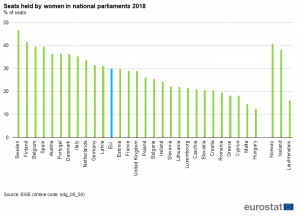This week’s reading by Kari Norgaard and Richard York, introduced us to the concept of environmentalism, the government, and gender equality. It was a concept I never really put together until now. The environment is a hot topic around the world, especially in political arenas. Many world leaders are ultra focused on climate policies and how to implement the best plans to help cut back their total emissions and reduce their carbon footprint. According to Norgaard and York, women who hold political office tend to be more proactive about environmental issues. I found this claim to be true as I began doing my own independent research.

Jacinda Ardern, the Prime Minister for New Zealand is very passionate about climate control issues. Ardern has called the climate emergency her generation’s “nuclear free moment” and made tackling it a priority for her coalition government.”(AingeRoy) The New Zealand government is taking large steps toward reducing their emissions drastically by 2050. They have committed to planting a billion trees, implemented strict policies for farmers to reduce their emissions or face extremely high taxes, and putting a cap on the number of cows that dairy’s can have. New Zealand’ Environmental Performance Index (EPI) is currently ranked number 17 in the world by the UN. Ardern is pushing for net zero emissions by 2050, from watching her speak, it appears as though she is passionate about seeing that come to fruition. https://youtu.be/Dp5Ue9v2v7g
 The information about New Zealand’s Prime Minister Jacinda Ardern falls in line with York and Norgaard’s findings. Their research suggests that “nations with greater gender equality may be more prone to protecting the environment.” We see this with New Zealand, Denmark, Germany and Norway. “Women tend to take environmental risks like nuclear power or toxic substances more serious than men do.” (Norgaard & York 508). It’s not surprising that women tend to think more along the lines of environmental protection. Women have been conditioned by society to be nurturers and caregivers. Given that it would be natural that women would be more concerned about the air they breathe or the water their children drink and so on.
The information about New Zealand’s Prime Minister Jacinda Ardern falls in line with York and Norgaard’s findings. Their research suggests that “nations with greater gender equality may be more prone to protecting the environment.” We see this with New Zealand, Denmark, Germany and Norway. “Women tend to take environmental risks like nuclear power or toxic substances more serious than men do.” (Norgaard & York 508). It’s not surprising that women tend to think more along the lines of environmental protection. Women have been conditioned by society to be nurturers and caregivers. Given that it would be natural that women would be more concerned about the air they breathe or the water their children drink and so on.

The Prime Minister of Denmark Mette Frederiksen, is another woman who is leading her country on the road to reducing their emissions. Her pledge to cut greenhouse gas emissions by 70% by 2050 is laid out in an 18 page agreement titled “a fair direction for Denmark.” In this agreement she pledges to cut the sale of new diesel and petrol cars by 2030. “As it is, Denmark reached an emissions reduction of 35% in 2018” (Stam June 2019). Denmark’s EPI score is 3rd in the world according to 2018 data by the Environmental Performance Index.
In 1990, the “UN estimated that in order for women to influence key outcomes and be taken seriously, a threshold of 30% of women in parliament was required. As of 1999, only 8 of the 130 nations met this threshold.” Those nations included Denmark, Finland, Netherlands, South Africa, Germany, Iceland, Norway and Sweden (Norgaard & York 514). These numbers have increased since 1999. Below is a graph showing the number of seats held by women in across various national Parliaments. In 2018, Sweden had the leading number of women in its Parliament reporting at 47%. Sweden ranks number 5 in the world on their EPI. Despite the fact that their leader is a male, they have a large number of female members in their Parliament.

Norgaard and York posits that “gender equality and environmental concern are linked to the relationship between gender and the environment. ” Their study suggests that “societies that are less sexist are more environmentally responsible.” They mention further that a country like Singapore for example has a very low number of women in Parliament. As such, their environmental record is poor, ” holding one of the 10 worst environmental records in the world” (Norgaard & York).
 It’s a shame that the United States still has a disproportionate numbers of women in high ranking government positions. Women make up only 26% in the Senate and 23% in the House. The United States has an EPI score of 27 as of 2018. That number is not likely to rise with Trump in office. Alexandria Ocasio-Cortez is very vocal about climate change and is trying to come up with ways to cut emissions in the U.S. You can view her speech here; https://youtu.be/Whrwt5m9jHw This is further proof that women take on the challenge of environmental issues in a big way. “The youngest woman to be ever elected to congress, and an example of a millennial in power, AOC has been using her political position to draw attention to social and environmental issues as well as women’s rights and equality. Her work on and in promoting the Green New Deal in the U.S. has made her the voice of climate change concern in a political environment heavily criticised for climate change denial” (Wyns, A). AOC has moxy, she isn’t afraid to fight for what she believes in. With more women like her in the American government, we may have a chance for equality.
It’s a shame that the United States still has a disproportionate numbers of women in high ranking government positions. Women make up only 26% in the Senate and 23% in the House. The United States has an EPI score of 27 as of 2018. That number is not likely to rise with Trump in office. Alexandria Ocasio-Cortez is very vocal about climate change and is trying to come up with ways to cut emissions in the U.S. You can view her speech here; https://youtu.be/Whrwt5m9jHw This is further proof that women take on the challenge of environmental issues in a big way. “The youngest woman to be ever elected to congress, and an example of a millennial in power, AOC has been using her political position to draw attention to social and environmental issues as well as women’s rights and equality. Her work on and in promoting the Green New Deal in the U.S. has made her the voice of climate change concern in a political environment heavily criticised for climate change denial” (Wyns, A). AOC has moxy, she isn’t afraid to fight for what she believes in. With more women like her in the American government, we may have a chance for equality.
It’s important that nations begin to equal out the number of men and women in high ranking government offices. It’s imperative for gender equality. It’s not only important for equality, but for our planet. We need an equal balance for equality. When one class has more power than another, oppression occurs. Environmental organizations like WEDO can help create awareness and empowerment among women to join the environmental fight. The more empowered women feel the more apt they are to get involved in government, to enact policy change. We saw this happen in congress in 2018 Trump’s election.
Annotated Bibliography Eleanor AingeRoy is a journalist for the Guardian. She graduated from the University or Technology in Sydney. She was a freelance journalist prior to becoming a full-time writer for the Guardian. She is only 25, but tackles some very heavy story lines including covering the current Covid-19 outbreak in New Zealand.
Sources;
Ainge, E., Climate change to steer all New Zealand government decisions from now on, 12/2019, accessed 3/22/2020. https://www.theguardian.com/world/2019/dec/04/climate-change-to-steer-all-new-zealand-government-decisions-from-now-on
Davidson, J. AOC Reads the Green New Deal Into the Congressional Record 2/27/20, accessed 3/21/2020 https://www.ecowatch.com/aoc-green-new-deal-2645318946.html
EPI https://epi.envirocenter.yale.edu/2018/report/category/hlt
EU Stats, Women in EU parliament and governments https://ec.europa.eu/eurostat/web/products-eurostat-news/-/EDN-20190306-2
HerStory https://wedo.org/about-us-2/
Norgaard, Kari and Richard York. “Gender Equality and State Environmentalism.” Gender and Society August 2005: 506-522.
McDonald, J. New Zealand Takes the Lead on Climate Change, The Diplomat, 11/2019, accessed 3/22/2020. https://thediplomat.com/2019/11/new-zealand-takes-the-lead-on-climate-change/
Stay, C. New Danish government puts climate change centre stage, 6/2019, accessed 3/21/2020 https://www.euractiv.com/section/climate-environment/news/new-danish-government-puts-climate-change-centre-stage/


Have you ever considered creating an ebook or guest
authoring on other websites? I have a blog based on the same information you
discuss and would really like to have you share some stories/information. I know my
viewers would appreciate your work. If you are even remotely interested, feel free to shoot me an e-mail.
Take a look at my website – ultimateshop
Access ultimateshop.mp for high-quality cc, cvv, and fullz files. Log in now to explore all features.
Howdy! I could have sworn I’ve been to this website before but after browsing through some of the
post I realized it’s new to me. Nonetheless, I’m definitely happy I found it and I’ll
be book-marking and checking back frequently!
Hello there! Would you mind if I share your blog with my zynga group?
There’s a lot of folks that I think would really appreciate your content.
Please let me know. Thanks
Thanks for any other wonderful article. Where else may just anyone
get that kind of information in such an ideal approach
of writing? I’ve a presentation next week, and I am at the look for such information.
excellent post, very informative. I wonder why the other
specialists of this sector do not realize this. You should proceed your writing.
I’m confident, you have a huge readers’ base already!
First off I want to say excellent blog! I had a quick question that I’d like to ask if you do not mind.
I was interested to know how you center yourself and clear your thoughts before
writing. I’ve had a difficult time clearing my mind in getting my thoughts out there.
I do take pleasure in writing however it just seems like the first 10 to 15 minutes tend to be
wasted just trying to figure out how to begin. Any recommendations or tips?
Cheers!
Thanks for the good writeup. It if truth be told was once a entertainment account it.
Look advanced to more brought agreeable from you! However, how can we be in contact?
We are a group of volunteers and starting a new scheme in our community.
Your website offered us with valuable information to work
on. You’ve done an impressive job and our whole community will be thankful to you.
Hey I know this is off topic but I was wondering if you knew of any widgets I could add to my blog that automatically tweet my newest twitter updates.
I’ve been looking for a plug-in like this
for quite some time and was hoping maybe you would have some experience with something like this.
Please let me know if you run into anything. I truly enjoy reading
your blog and I look forward to your new updates.
What’s Taking place i’m new to this, I stumbled
upon this I’ve found It positively helpful and it has aided me
out loads. I am hoping to give a contribution & aid different users
like its helped me. Great job.
Hi there, I enjoy reading all of your article. I wanted to write a little comment
to support you.